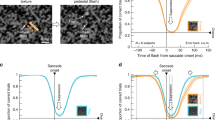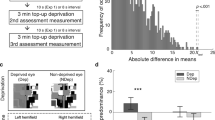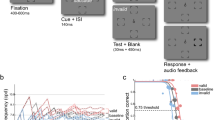Abstract
Abnormal visual development in strabismic amblyopia drastically affects visual perception and properties of neurons in primary visual cortex (V1). To test the notion that amblyopia also has consequences for higher visual areas, we asked humans with amblyopia to count briefly presented features. Using the amblyopic eye, strabismic amblyopes counted inaccurately, markedly underestimating the number of features. This inaccuracy was not due to low-level considerations (blur, visibility, crowding, undersampling or topographical jitter), as they also underestimated the number of features missing from a uniform grid. Rather, counting deficits in strabismic amblyopes reflected a higher-level limitation in the number of features the amblyopic visual system can individuate.
This is a preview of subscription content, access via your institution
Access options
Subscribe to this journal
Receive 12 print issues and online access
$209.00 per year
only $17.42 per issue
Buy this article
- Purchase on Springer Link
- Instant access to full article PDF
Prices may be subject to local taxes which are calculated during checkout






Similar content being viewed by others
References
Weisel, T. N. Postnatal development of the visual cortex and the influence of environment. Nature 299, 583–591 (1982).
Smith, E. L., III et al. Residual binocular interactions in the striate cortex of monkeys reared with abnormal binocular vision. J. Neurophysiol. 78, 1353–1362 (1997).
Kiorpes, L., Kiper, D. C., O'Keefe, L. P., Cavanaugh, J. R. & Movshon, J.A. Neuronal correlates of amblyopia in the visual cortex of macaque monkeys with experimental strabismus and anisometropia. J. Neurosci. 18, 6411–6424 (1998).
Hess, R.F. Developmental sensory impairment: amblyopia or tarachopia. Hum. Neurobiol. 1, 17–29 (1982).
Levi, D.M. in Vision and Visual Dysfunction. Vol. 10B (ed. Cronly-Dillon, J.) 212–238 (Macmillan, New York, 1991).
Levi, D. M. & Klein, S. A. Vernier acuity, crowding and amblyopia. Vision Res. 25, 979–991 (1985).
Levi, D. M. & Klein, S.A. Sampling in spatial vision. Nature 320, 360–362 (1986).
Wang, H., Levi, D. M. & Klein, S.A. Spatial uncertainty and sampling efficiency in amblyopic position acuity. Vision Res. 38, 1239–1251 (1998).
Levi, D. M., Klein, S. A. & Sharma, V. Position jitter and undersampling in pattern perception. Vision Res. 39, 445–465 (1999).
Pylyshyn, Z. et al. Multiple parallel access in visual attention. Can. J. Exp. Psychol. 48, 260–283 (1994).
Trick, L. M. & Pylyshyn, Z.W. Why are small and large numbers enumerated differently? A limited-capacity preattentive stage in vision. Psychol. Rev. 101, 80–102 (1994).
Jevons, W.S. The power of numerical discrimination. Nature 3, 281–282 (1871).
Atkinson, J., Campbell, F. W. & Francis, M.R. The magic number 4 ± 0: A new look at visual numerosity judgments. Perception 5, 327–334 (1976)
Levi, D. M. & Harwerth, R.S. Spatiotemporal interactions in anisometropic and strabismic amblyopia. Invest. Ophthalmol. Vis. Sci. 16, 90–95 (1977).
Hess, R. F. & Howell, E.R. The threshold contrast sensitivity function in strabismic amblyopia: Evidence for a two-type classification. Vision Res. 17, 1049–1055 (1977).
Bradley, A. & Freeman, R.D. Contrast sensitivity in anisometropic amblyopia. Invest. Ophthalmol. Vis. Sci. 21, 467–476 (1981).
Chino, Y. M., Smith, E. L. 3rd, Yoshida, K., Cheng, H. & Hamamoto, J. Binocular interactions in striate cortical neurons of cats reared with discordant visual inputs. J. Neurosci. 14, 5050–5067 (1994).
Roelfsema, P. R., Konig, P., Engel, A. K., Sireteanu, R. & Singer, W. Reduced synchronization in the visual cortex of cats with strabismic amblyopia. Eur. J. Neurosci. 6, 1645–1655 (1994).
Posner, M.I. Orienting of attention. Q. J. Exp. Psychol. 32, 3–26 (1980).
Eriksen, C. W. & Murphy, T.D. Movement of attentional focus across the visual field: A critical look at the evidence. Percept. Psychophys. 42, 299–305 (1987).
Nakayama, K. in Visual Coding and Efficiency (ed. Blakemore, C.) 411–422 (Cambridge Univ. Press, Cambridge, 1990).
Lu, Z. L. & Dosher, B. A. External noise distinguishes attention mechanisms. Vision. Res. 38, 1183–1198 (1998).
Levi, D. M., Waugh, S. J. & Beard, B.L Spatial scale shifts in amblyopia. Vision Res. 34, 3315–3334 (1994).
Balakrishnan, J. D. & Ashby, F.G. Subitizing: magical numbers or mere superstition? Psychol. Res. 54, 80–90 (1992).
Sathian, K. et al. Neural evidence linking visual object enumeration and attention. J. Cogn. Neurosci. 11, 36–51 (1999).
Treisman, A.M. Feature binding, attention and object perception. Phil. Trans. R. Soc. Lond. B Biol. Sci. 353, 1295–1206 (1998).
Vuilleumier, P. & Rafal, R. "Both" means more than "two": localizing and counting in patients with visuospatial neglect. Nat. Neurosci. 2, 783–784 (1999).
Hyvarinen, J., Hyvarinen, L. & Linnankoski, I. Modification of parietal association cortex and functional blindness after binocular deprivation in young monkeys. Exp. Brain Res. 42, 1–8 (1981).
Imamura, K. et al. Reduced activity in the extrastriate visual cortex of individuals with strabismic amblyopia. Neurosci. Lett. 225, 173–176 (1997).
Kooi, F. L., Toet, A., Tripathy, S. P. & Levi, D. M. The effect of similarity and duration on spatial interaction in peripheral vision. Spat. Vis. 8, 255–279 (1994).
He, S., Cavanagh, P. & Intriligator, J. Attentional resolution and the locus of visual awareness. Nature 383, 334–337 (1996).
Watson, A.B. Probability summation over time. Vision Res. 19, 515–522 (1979).
Acknowledgements
We are grateful to Ailene Kim for her help with the ‘missing patches’ experiment and Y. Chino for discussions on an early draft of this paper. This research was supported by research grants R01EY01728 and RO1 EY04776, a Core Center Grant P30EY07551, and short-term training grant T35EY07088 from the National Eye Institute, NIH.
Author information
Authors and Affiliations
Corresponding author
Rights and permissions
About this article
Cite this article
Sharma, V., Levi, D. & Klein, S. Undercounting features and missing features: evidence for a high-level deficit in strabismic amblyopia. Nat Neurosci 3, 496–501 (2000). https://doi.org/10.1038/74872
Received:
Accepted:
Issue Date:
DOI: https://doi.org/10.1038/74872
This article is cited by
-
Perceptual learning with dichoptic attention tasks improves attentional modulation in V1 and IPS and reduces interocular suppression in human amblyopia
Scientific Reports (2022)
-
Distorted optical input affects human perception
Scientific Reports (2020)
-
Tilt after-effect from high spatial-frequency patterns in the amblyopic eye of adults with anisometropic amblyopia
Scientific Reports (2015)
-
Amblyopia: a mini review of the literature
International Ophthalmology (2011)
-
Het luie oog en het schele oog
Neuropraxis (2001)



